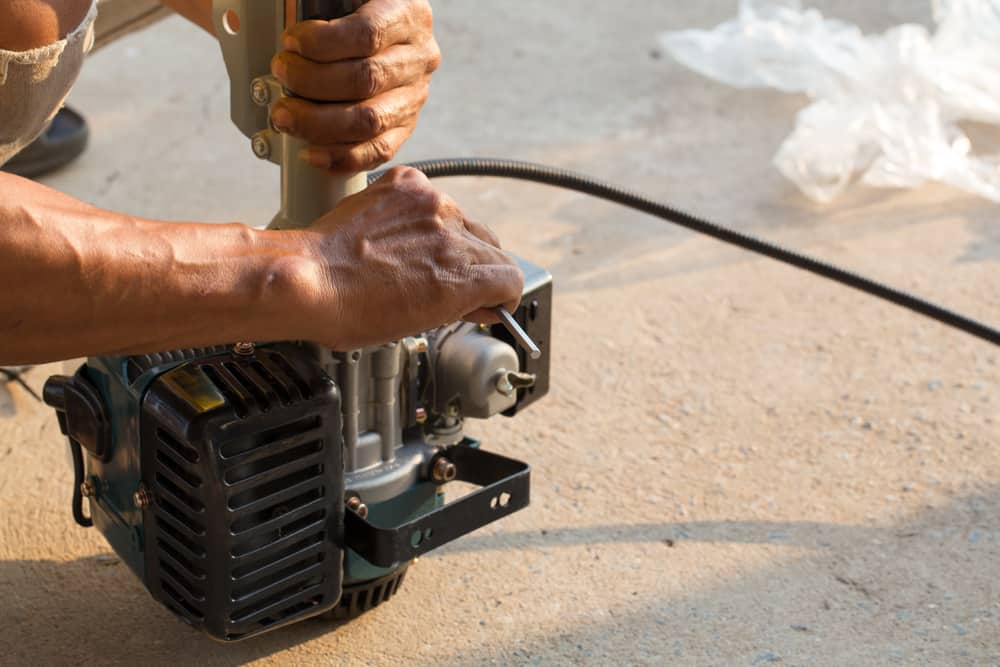If you’re in the market for a new trimmer, you have probably spent a lot of time weighing the advantages and disadvantages of the different types available. You will have thought about the relative merits of gas-powered, corded electric and battery-powered models and you may also have considered other variables like straight or curved shafts and so on.
If you have decided gas power is the way to go, you may still be wondering whether you should choose a 2 Cycle model or a 4 Cycle model. What is the difference? Which one performs better? And which one is best for you? Here, we address questions like this and more as we discuss the differences between a 2 Cycle vs 4 Cycle trimmer.
Here’s a very excitable reviewer talking about some of the differences between 2- and 4-stroke models.
2 Cycle vs 4 Cycle Trimmer – How they work?
If you are reading this, presumably you are interested in this question for the practical purposes of choosing a weed eater for your yard rather than for reasons of pure mechanical curiosity.
For this reason, we don’t need to go too deep into the workings of 2 Cycle vs 4 Cycle engines, but it is worth taking a few moments to understand how they both function at the most basic level.
The number of cycles – sometimes also referred to as strokes – refers to the number of strokes the pistons in the engine need to make to produce power. In a 2-stroke engine, power is generated every two strokes while in a 4-stroke engine, four strokes are required.
Traditionally, simpler 2 Cycle engines have been more commonly used in smaller applications such as trimmers or lawnmowers whereas larger 4 Cycle string trimmer engines are more commonly found in cars.
However, smaller garden tools can also incorporate 4 Cycle engines, so now we need to look at which is the better option. We can break this down by looking at the relative strengths of each type.
What are the strong points of a 2 Cycle engine?

Here are the areas in which a 2 Cycle engine outperforms a 4 Cycle version.
· Power
All other things being equal – and by this, we mean the size of the engine and the type of fuel being used – a 2 Cycle engine will produce more raw power than a 4 Cycle version.
The reason for this is simple. Since only two strokes are required to produce power, the 2 Cycle engine has less work to do and so has greater power output.
A 4 Cycle engine, on the other hand, has more work to do and so creates less power – although this is not the whole story, as we will see shortly.
· Cost
2 Cycle engines come out on top in terms of cost because they are less complex. They are the more basic type of engine and cost less to make, meaning a tool incorporating a 2 Cycle engine will always sell for less than a similar tool that is powered by a 4 Cycle engine.
· Weight
We are generalizing here, but again, with all else being equal, 2 Cycle engines weigh less because they are simpler. Since the engine is the heaviest part of a trimmer, versions with 2 Cycle engines will usually weigh less than 4 Cycle models.
· Simplicity
Another point worth remembering is that since a 2 Cycle engine is a simpler machine, it has fewer moving parts and therefore there is less that can go wrong.
As with anything, once you start adding layers of complexity, there is more that can fail – meaning that at some point, something will eventually break down and need fixing or replacing. This is more likely with a 4 Cycle engine.
Where does a 4 Cycle engine beat a 2 Cycle one?

Although it seems that 2 Cycle engines have several big advantages over 4 Cycle versions, there are also some important areas where 4 Cycle models come out on top. Let’s have a look at these now.
· Fuel efficiency
Although a 2 Cycle engine might produce more raw power, it burns up more fuel to do it.
In a 2 Cycle engine, exhaust gases are never fully expelled and some of the gas mix is expelled through the exhaust without ever being used to generate power, all of which is not particularly efficient.
With a 4 Cycle version, on the other hand, the process is much more efficient – which means they require less fuel to produce the same result.
· Noise
When it comes to the amount of noise they make, the 4 Cycle engine is the clear winner – and by this we mean the 4 Cycle engine runs more quietly than a 2 Cycle version!
The reason is that with every down stroke, a 2 Cycle engine creates combustion, a small but loud explosion that escapes from the engine on every second stroke.
Of course, the same thing is happening in a 4 Cycle engine, but with a 4 Cycle engine, the combustion takes place inside the engine on the third stroke. This muffles the sound and makes it a lot quieter for people on the outside.
· Pollution
Although both burn gasoline and cause pollution, a 4 Cycle engine is slightly better for the environment. Of course, if you want to go completely green, a cordless weed eater would be a much better option than a gas weed eater.
· Gas and oil mix
There is one other important area where a 4-stroke engine is the undisputed champion, and that is in the fuel it needs.
In short, a 4 Cycle engine stores the gas and the oil that is needed to lubricate it separately. This means as long as you keep the oil topped up, it self-lubricates while it is running.
Conversely, a 2 Cycle engine is unable to do this. Instead, it requires fuel that is a mix of gasoline and oil – usually in a ratio of one part oil to 50 parts gasoline (although this it can vary).
With a 4 Cycle engine, you just add gas and oil separately – you don’t need to worry about mixing them up and adding them together.
For this one simple reason, a trimmer with a 4 Cycle engine can seem a lot less hassle than a machine with a 2-stroke engine.
Which is best? It depends on you

As we have seen, there are a few significant differences between the two types, although, in general terms, both are capable of getting the job done.
There is no “best” option, and the right choice depends on what you value. If you want a simple but powerful machine and don’t mind the noise or extra pollution, a 2-stroke might suit you well.
However, if you prefer a quieter, more efficient machine – and one that doesn’t require a gas-oil mix to run – a 4-stroke might be a wiser choice.

Leave a comment